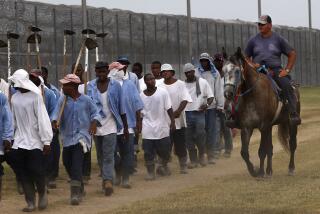Book Review : History of Female Slaves in the South Is Revised
- Share via
Ar’n’t I a Woman?: Female Slaves in the Plantation South by Deborah Gray White (Norton: $18.95)
This angry, illuminating book about female slavery is not focused on or addressed to the public in general, but is a fusillade in an ongoing argument with sociologists, anthropologists, historians and self-styled pundits who may be either black or white, but are always men. It’s bad enough, Deborah Gray White tells us, that black women have had to suffer for years as slaves, considered inferior both because they were black in a white-dominated culture and because they were women in a patriarchal society.
But in recent times, simply because they have survived, they have been seen--again by male “authorities”--as having had a deleterious effect on black men: “When (E. Franklin) Frazier wrote that slave women were self-reliant and that they were strangers to male slave authority he evoked the image of a domineering woman. The effect of his conclusions was to malign slave women for struggling to pull their families together. . . .”
Real Condition
“Slave women suffered from the malevolence that flowed from both racism and sexism,” White writes. But even worse, or at least just as bad, they suffered from being defined by “pundits” who knew next to nothing about their real condition, and black women endure these insults even today. Daniel Moynihan, a white Irishman, had this to say in 1965: “The fundamental fact of Negro-American family life is the often-reversed roles of husband and wife,” and White paraphrases his advice: “Moynihan found the black woman’s role debilitating for black men, so much so that in 1965 he advised black men to seek refuge in the armed forces, a world which, according to Moynihan, offered a “dramatic and desperately needed change, because it was ‘a world away from women.’ ” Of course, black men who might have taken his advice faced some unpleasant times in Vietnam, but better death than being henpecked. . . .
All this makes White fighting mad. She’s particularly furious at sociologist Calvin Hernton, who “concluded that the cumulative effects of slavery and discrimination had produced in black women a sort of ‘studdism.’ Hardship, he argued, had made black women rigid.” This stereotype of “Sapphire,” an emasculating dragon lady, is the third insulting slur to be heaped upon black women after centuries of being labeled a Jezebel--promiscuous, amoral, panting after sex--and, after she reaches the end of her childbearing years, Mammy, that eternally cheerful lady who looks after the children and dishes up pancakes, and is the backbone of the Southern household.
Intelligent Whites
Talk about male (and female) fantasies! Even the most intelligent whites in the South were not free from these soothing illusions: William Faulkner’s Dilsey, trudging uncomplainingly up and down those never-ending steps, living only to serve and to endure, transcends normal humanity because she wasn’t human. A human might have said, to the selfish members of the white family she served, “Ah, get it yourself!”
And several of the slaves recorded here did just that. White, irritated even further by male historians who extol the virtues and bravery of the male slave, while totally ignoring the lot of the female--just what she did, how she lived, what was important to her--has gone back to the memoirs and personal accounts of the time, and shown us a segment of American history that has previously been ignored.
White has found that female slaves had few chances to run away--that comparative lack of physical strength and the responsibilities of children tended to keep them on the plantation. The black woman had to learn to cope, to survive, exactly where she was. If she did not run away, at least she could play truant. Many slaves hid for days, weeks in the countryside. And if she was not protected by legal marriage, she was not victimized by the strictures of that institution.
As a child she grew up with other boys and girls, often roamed the woods on a fairly equal basis with the boys, looked after by a “granny” while her mother worked in the field. When she reached childbearing age and became pregnant, she often worked in the plantation “trash gang” with older women and nursing mothers, where she was able to make strong female friendships.
Strong Case
After her childbearing years (during which she was treated relatively humanely because she was an economic asset to the plantation), she worked terribly hard during her middle age. As an elderly woman she might be sold, but if she was lucky or ingenious, she might have become a midwife, or an authority on herbs, or a conjurer, in which case she was treated with respect.
White makes the strong case that many tribes in West Africa segregate male from female, that women, for centuries, had lived in separate dwellings with their children, and that the husband-wife connection had been comparatively superficial. The circumstances of slavery only reinforced cultural patterns that were already in place, and, as such, were not necessarily bad. Equality does not equate with emasculating domination.
Role of Sex
Faced with sexual exploitation by white male plantation owners and overseers, black women reacted in many different ways. Sometimes they seduced masters away from their wives. Sometimes they resisted rape fiercely, ganging up on the overseer who was imprudent enough to pursue several slaves at once. Sometimes, most often, it seems, they accepted motherhood as something sacred in itself, gathering identity and status from the children they produced. Other times, they killed their babies rather than see them grow up in slavery.
White seems to fudge a little on her theories of sexual permissiveness vs. puritanism. Some girl slaves were so ignorant of the mechanics of childbearing that they searched for babies in parsley fields. They attached little importance to premarital sex, but on the average had no children until they were 20. Yet, White says, they had no “visible means of birth control.” This section clearly needs some work. But for the most part the materials collected here are valuable and engrossing. The bibliography alone makes this book worthwhile for black studies enthusiasts, feminists, students of American history. Daniel Moynihan might want to take a look at it too.


